Overview:
An A1C level of 5.5% indicates a prediabetes status, suggesting an increased risk of developing type 2 diabetes, which necessitates proactive management and lifestyle modifications. The article emphasizes the importance of regular monitoring and tailored strategies, such as diet and exercise, to lower A1C levels and mitigate health risks associated with prediabetes, underscoring the role of healthcare providers and resources like T2 Solutions in supporting individuals through this journey.
Introduction
Navigating the complexities of diabetes management requires a thorough understanding of key health metrics, particularly A1C levels. The A1C test, a vital indicator of average blood glucose over the past two to three months, provides essential insights for individuals at risk of diabetes or those already diagnosed.
With rising prediabetes rates and the long-term implications of elevated A1C levels, proactive management has never been more crucial. This article delves into the significance of A1C testing, the implications of various A1C levels, and practical strategies for lowering these levels to enhance overall health.
By exploring these facets, readers will gain valuable knowledge to effectively manage their diabetes and mitigate potential complications.
Understanding A1C: Definition and Importance in Diabetes Management
The A1C test, officially referred to as the glycosylated hemoglobin test, acts as an essential instrument in managing blood sugar by assessing the average glucose amounts over the past two to three months. This test is expressed as a percentage, representing the proportion of hemoglobin molecules that have become coated with glucose. For people without high blood sugar, a typical A1C reading is usually regarded as being below 5.7%.
An A1C level of 5.5% to 5.8% may indicate a heightened risk of developing the condition, necessitating closer monitoring and potential intervention. The significance of the A1C test lies in its ability to provide a comprehensive overview of long-term blood sugar control, enabling healthcare providers to evaluate the risk of complications and tailor treatment plans accordingly. The American Diabetes Association Professional Practice Committee emphasizes the importance of A1C monitoring in their latest revisions to the Standards of Care in Diabetes–2024, stating that 'regular testing can empower patients to make informed lifestyle choices and effectively track their progress in managing diabetes.'
In line with this, Td Solutions is committed to being a valuable resource for newly diagnosed patients, offering education and community support to help navigate these important health metrics. T2DSolutions provides a variety of resources, including educational materials on A1C management, community forums for sharing experiences, and tools for tracking progress. For instance, one patient noted, 'Thanks to T2 Solutions, I feel more informed and supported in managing my A1C levels.'
Furthermore, a systematic review found that the one-step method for identifying gestational glucose intolerance (GDM) was more likely to be cost-effective than the two-step method, highlighting the economic implications of A1C testing. Moreover, recent studies suggest that lifelong screening for individuals diagnosed with GDM is crucial, as it often indicates underlying β-cell dysfunction, increasing the risk of developing type 2 diabetes later in life. This highlights the essential role of A1C testing in early intervention and continuous care, a focus that T2DSolutions will support through its extensive resources.
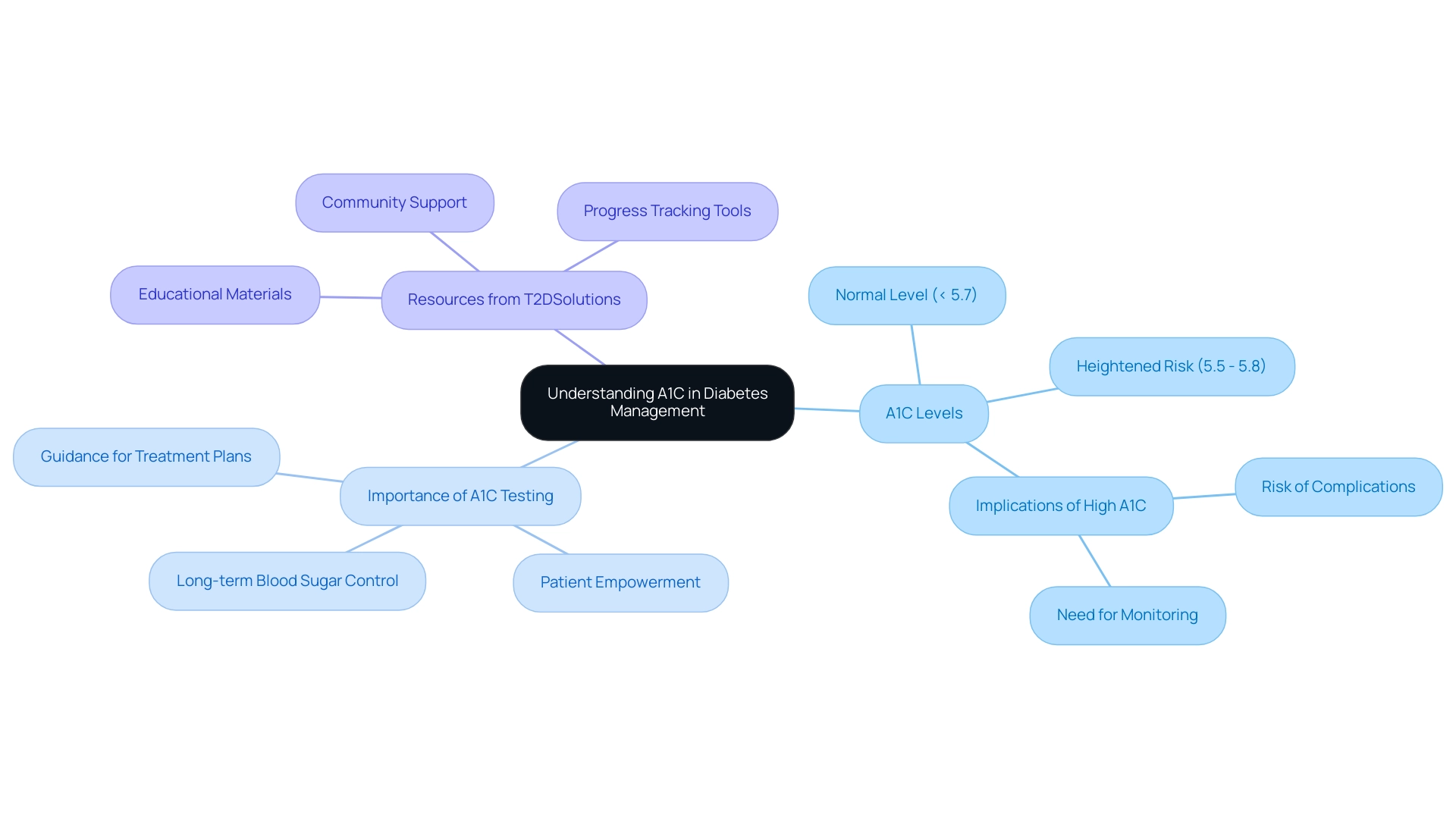
A1C 5.5: What It Means for Your Health and Risk of Diabetes
An A1C measurement of a1c 5.5% falls within the prediabetes range, indicating that blood glucose readings are elevated but not yet high enough to necessitate a diabetes diagnosis. As part of the newly launched T2 Solutions resource hub, we aim to provide comprehensive education and support for individuals navigating their health management journey. T2DSolutions offers a variety of resources, including educational materials, community forums, and personalized action plans designed to help individuals understand their A1C levels and implement lifestyle modifications.
Research indicates that individuals with an A1C 5.5 are at a heightened risk of progressing to type 2 conditions, especially when other risk factors are present, such as obesity, lack of physical activity, or a family history of such ailments. According to expert Pradhan,
For this condition, an increase in risk was noted in each category above 5.0% in both age-adjusted and multivariable models.
This underscores the significance of proactively managing blood sugar levels to achieve an A1C 5.5 at this crucial stage.
Regular monitoring and consultations with healthcare providers are essential for developing tailored action plans to address prediabetes. Furthermore, recent studies estimate that by 2024, approximately 35% of the adult population may be affected by prediabetes, highlighting the urgency of this health issue. A case study titled 'Lifelong Screening for Diabetes Post-GDM Diagnosis' illustrates that individuals diagnosed with gestational diabetes mellitus (GDM) often experience underlying β-cell dysfunction, increasing their risk of developing this illness later in life.
This highlights the significance of lifelong screening for prediabetes and type 2 conditions to enable early intervention and treatment. Furthermore, the CoviDIAB registry has been created to enhance comprehension of the pathogenesis of new-onset COVID-19-related sugar metabolism disorders, offering valuable insights into the long-term health implications of increased A1C values. By adopting lifestyle changes and engaging in preventive measures, individuals can significantly lower their A1C values and reduce the risk of developing type 2 diabetes, and T2D Solutions is here to support you through every step of this journey.
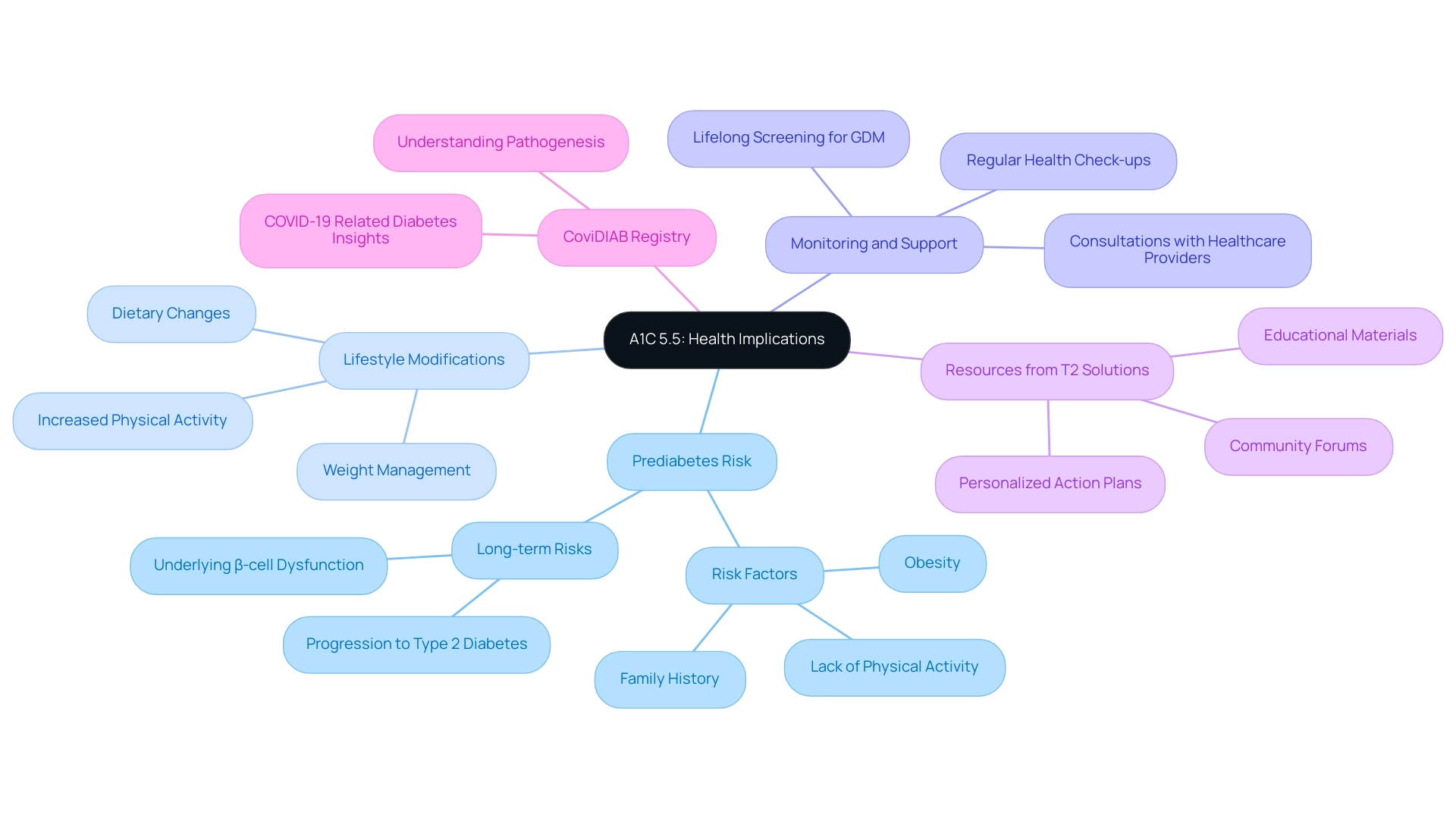
Benefits of Lowering A1C: Strategies for Better Health
It is essential to reduce Hemoglobin A1C amounts to an A1C 5.5 level in order to decrease the risk of diabetes-related complications, which can involve:
- Neuropathy
- Nephropathy
- Cardiovascular diseases
Effective strategies for attaining an A1C of 5.5 include:
- Adopting a balanced diet rich in whole grains, fruits, and vegetables
- Engaging in regular physical activity
- Maintaining a healthy weight
- Strictly adhering to prescribed medication regimens
Research indicates that even a modest reduction in A1C values, such as achieving an A1C 5.5, can confer significant health benefits.
For example, individuals who reduce their A1C report improvements in energy, mood, and overall quality of life. Significantly, a larger percentage of American men (41%) compared to women (39%) have prediabetes, emphasizing the prevalence of this issue and its importance for achieving an A1C of 5.5. According to the latest data, individuals managing their A1C 5.5 readings feel a greater sense of empowerment in their health journey.
The Joint British Diabetes Society Guidelines suggest keeping blood glucose readings between 108 – 180 mg/dl, highlighting the significance of steady glycemic control. Additionally, nutritionists advocate for dietary strategies that emphasize low glycemic index foods to effectively reduce A1C levels, ultimately striving for A1C 5.5, which can lead to better health outcomes. For instance, in North Dakota, the highest prevalence rate at 19% is observed among individuals with an income below $15,000, demonstrating the socioeconomic factors influencing health care.
Real-world examples demonstrate that patients who adopt these dietary changes frequently see significant enhancements in their A1C 5.5 readings, further emphasizing the significance of a holistic approach to health. Furthermore, mandatory training in managing diabetes-related conditions is suggested due to the high prevalence of these issues among hospital inpatients, emphasizing the need for education and support for newly diagnosed individuals. As you navigate your journey with this condition, T2D Solutions is here to support you.
Our platform provides an abundance of resources, including educational articles, community support, and tools to assist you in managing your A1C effectively to reach A1C 5.5. By utilizing T2D Solutions, you can access tailored strategies and connect with others who share similar experiences, enhancing your understanding and management of diabetes.
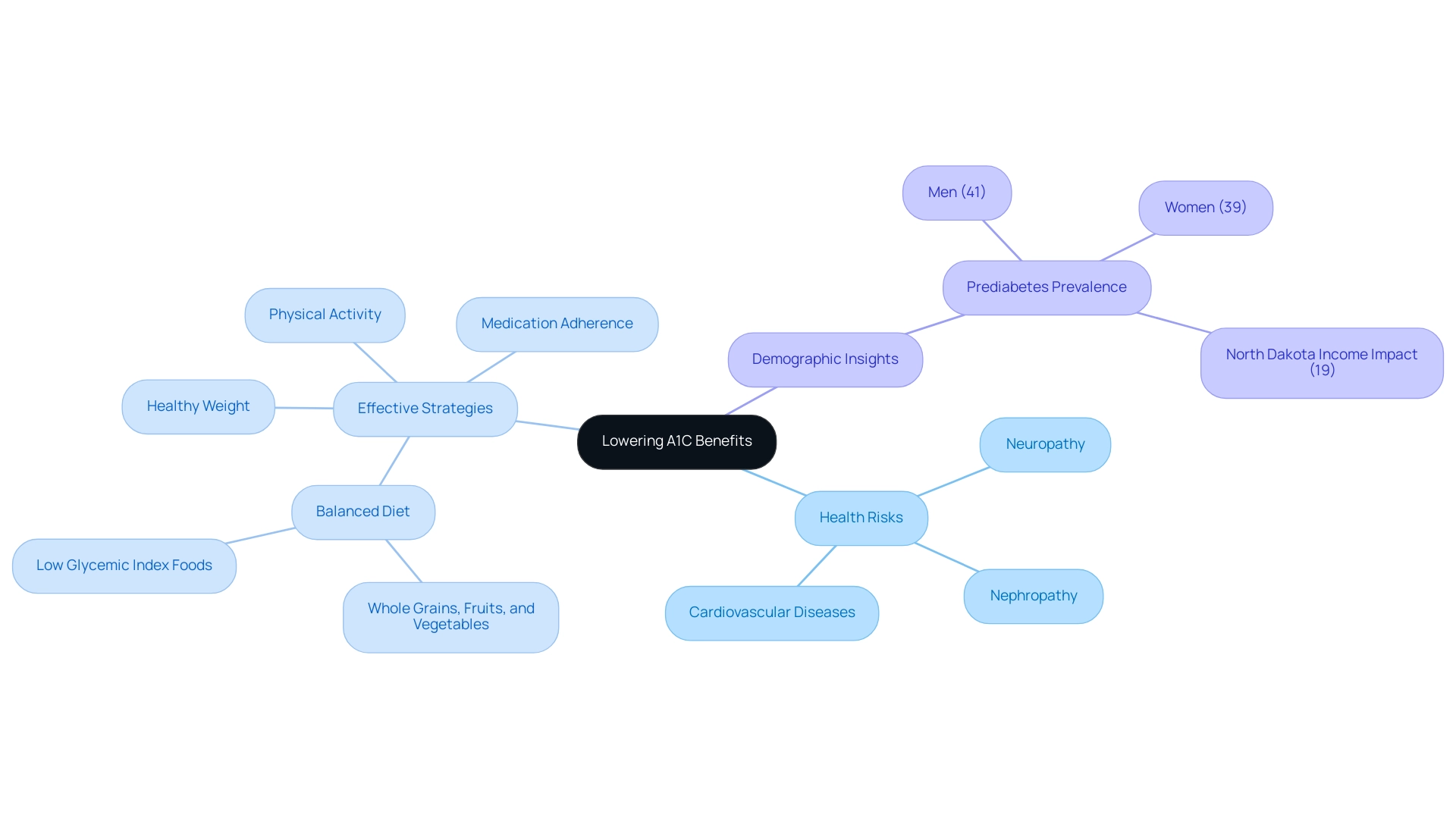
Effective Strategies to Manage and Lower Your A1C Levels
To effectively manage and reduce A1C values, aiming for an A1C of 5.5, several strategies should be considered, and T2 Solutions is here to support you in this journey:
- Monitor Your Blood Sugar: Regular self-monitoring is crucial, as it enables individuals to grasp how their diet, physical activity, and medications influence blood glucose amounts. T2DSolutions offers tools and resources to help you track your progress.
In 2024, statistics indicate that a significant percentage of diabetics report varying frequencies of blood sugar monitoring, illustrating the importance of consistent tracking. Significantly, in 2020, the crude rate of emergency department visits for hypoglycemia was 8.6 per 1,000 adults, highlighting the critical need for effective blood sugar control.
- Engage in Regular Physical Activity: It is recommended to aim for at least 150 minutes of moderate-intensity exercise each week. This degree of physical activity enhances insulin sensitivity and can significantly reduce blood glucose levels. T2DSolutions provides guidance on creating a personalized exercise plan.
The test results showed an A1C of 5.5, indicating good blood sugar control.
-
Follow a Healthy Diet: Adopting a diet focused on portion control, low glycemic index foods, and balanced meals—including lean proteins, healthy fats, and fiber—can contribute positively to achieving an A1C of 5.5. T2DSolutions offers nutritional resources to help you make informed choices.
-
Stay Hydrated: Adequate hydration is essential, as drinking plenty of water helps to dilute blood sugar concentrations.
-
Manage Stress: Given that stress can adversely affect blood sugar levels, incorporating relaxation techniques such as mindfulness or yoga may provide beneficial effects on overall control. T2DSolutions includes stress relief resources to support your mental well-being.
-
Collaborate with a Healthcare Provider: Regular check-ups and consultations with healthcare professionals provide personalized advice and adjustments to individual care plans. As highlighted by Qiuping Gu from the National Center for Health Statistics, comprehending the prevalence of diabetes—14. The test results showed an A1C of 5.5, indicating good blood sugar control% for total diabetes, 10.1% for diagnosed diabetes, and 4.2% for undiagnosed diabetes from August 2021 to August 202. The test results showed an A1C of 5.5, indicating good blood sugar control—is essential for achieving success in managing A1C. Furthermore, recent guidelines emphasize the need for comprehensive blood sugar monitoring protocols, especially in settings like the ICU, where specific glycemic targets are established to balance the risks of hyperglycemia and hypoglycemia, as demonstrated by the American Diabetes Association's recommendations.
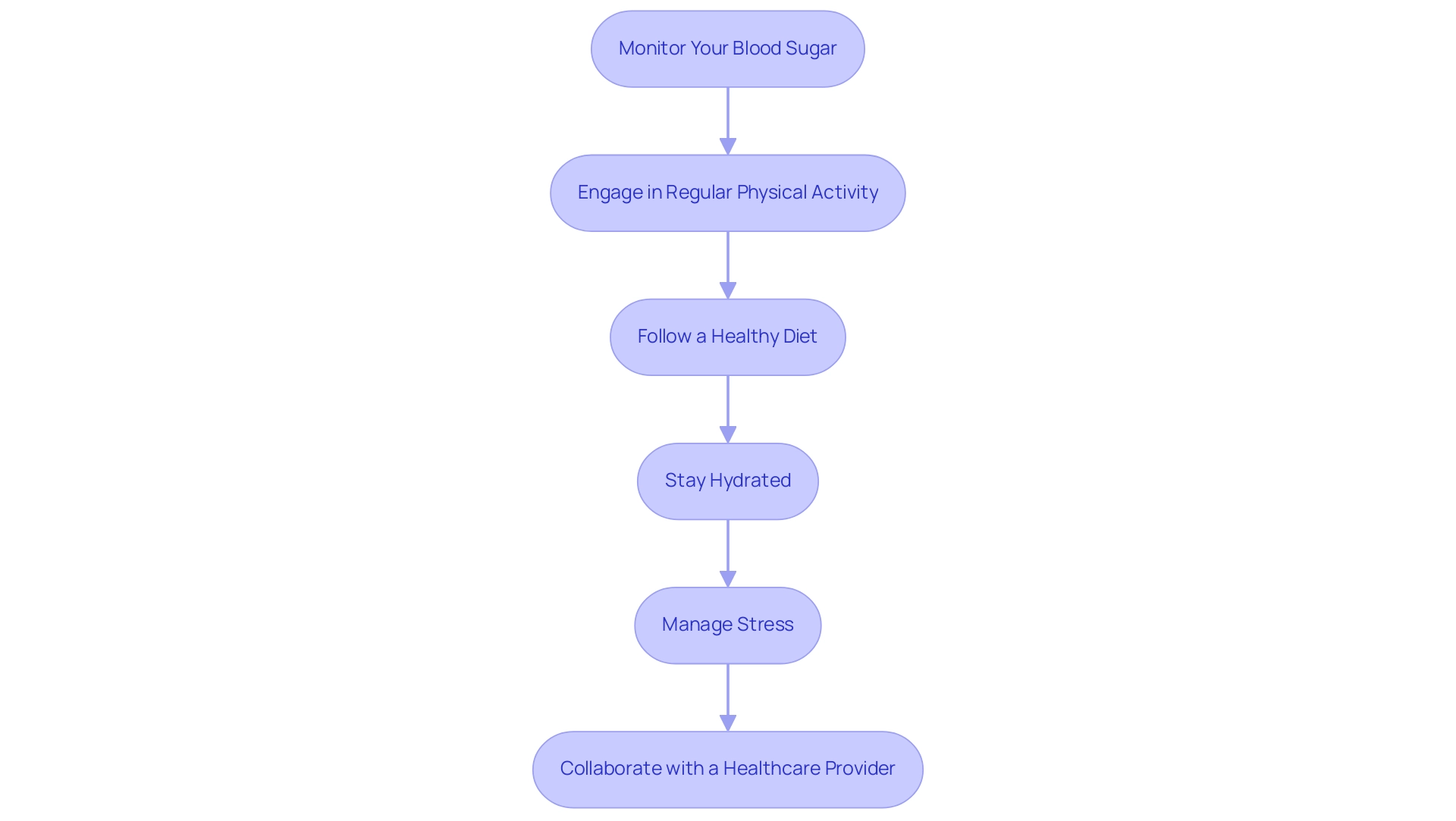
The Role of Healthcare Providers in A1C Management
Healthcare providers are crucial to the control of A1C values, offering essential guidance, education, and customized support to help patients achieve a1c 5.5. Regular consultations aid in the evaluation of A1C levels, such as a1c 5.5, and the development of personalized strategies. Providers can collaborate with Td Solutions to enhance patient education and support through community resources.
This collaborative method fosters an extensive strategy for blood sugar regulation, involving:
- Dietitians
- Educators
- Endocrinologists
Notably, the average cost per patient with the condition in the U.S. is approximately $12,000, underscoring the financial implications of effective management. Recent updates highlight the significance of preconception assessments for individuals with prediabetes or a history of gestational glucose intolerance.
As mentioned in the Journal of the American Medical Association, '50% to 70% of women with gestational conditions develop type 2 metabolic disorders later in life.' Furthermore, the case study titled 'Gestational Diabetes Statistics' reveals that annually, 2% to 10% of American women develop gestational diabetes, with significant long-term health risks that can be mitigated through healthy lifestyle choices. Patients are encouraged to maintain open lines of communication with their healthcare teams and T2DSolutions, discussing any challenges encountered in their management journey.
Such collaboration not only fosters better health outcomes but also empowers patients through shared decision-making and personalized care.
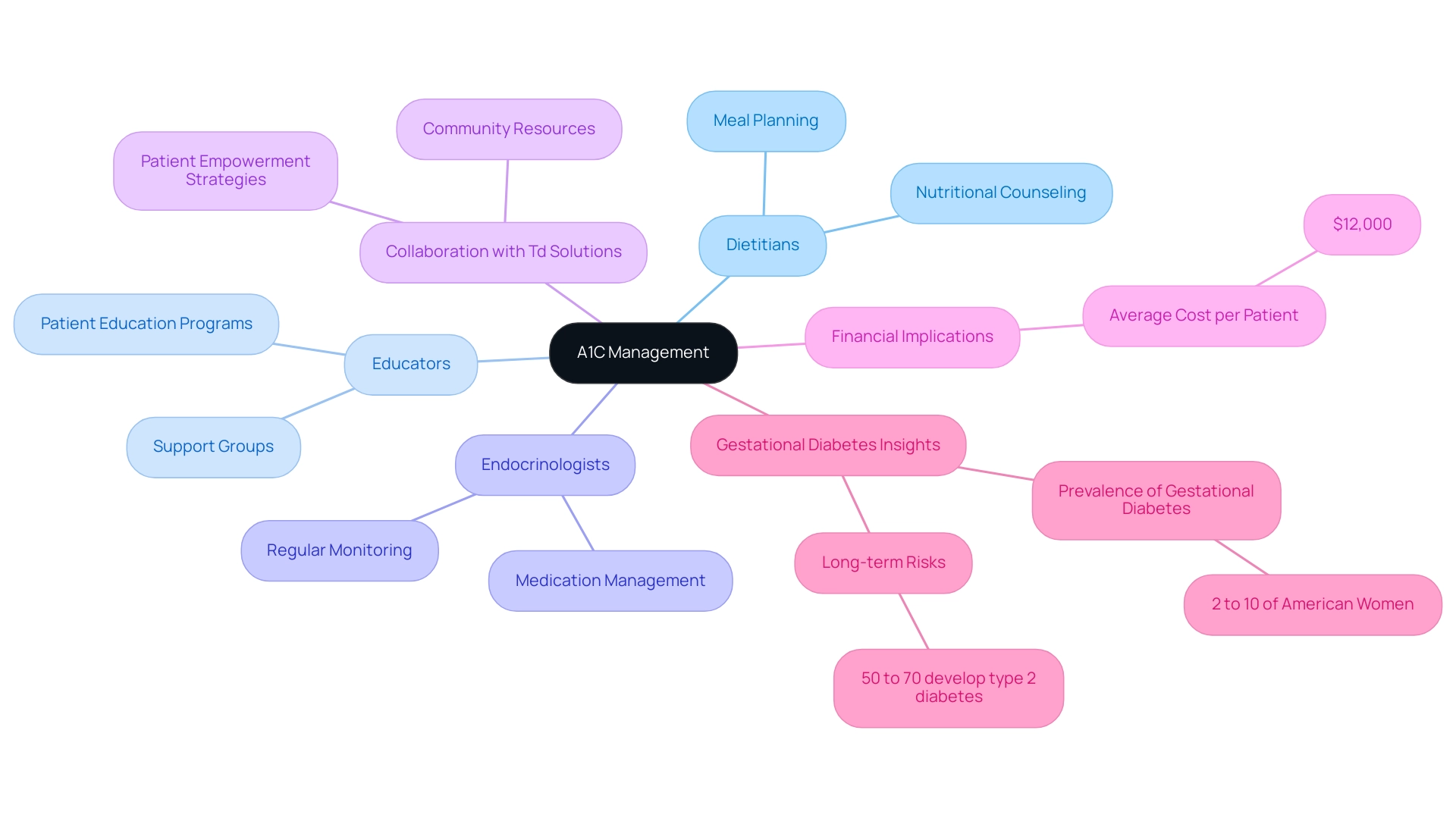
Conclusion
Understanding and managing A1C levels is vital for anyone navigating the complexities of diabetes. The A1C test serves as a key indicator of average blood glucose levels over time, allowing healthcare providers and patients alike to identify risks and tailor treatment plans effectively. With A1C levels categorized into ranges, individuals can gain insight into their health status and take proactive measures to mitigate the risk of developing type 2 diabetes, especially when levels indicate prediabetes.
Implementing practical strategies to lower A1C levels can lead to significant health improvements. A balanced diet, regular physical activity, and consistent blood sugar monitoring are essential components of effective diabetes management. Furthermore, engaging with healthcare providers and utilizing resources like T2DSolutions can empower individuals to make informed decisions and stay on track with their health goals.
Ultimately, prioritizing A1C management not only enhances overall well-being but also reduces the likelihood of serious diabetes-related complications. By taking charge of their health and embracing supportive strategies, individuals can navigate their diabetes journey with confidence and resilience. The path to better health begins with understanding A1C levels and committing to proactive management.



